Helgeland is the southern part of Nordland county in Norway between Trøndelag and the Arctic Circle right in the centre of Norway. The Helgeland coast is characterised by a wide belt of islands stretching some 50 km into the Atlantic and fjords that cut deep into the mainland. There are wide mountain areas partly protected as national parks. At the northern edge of Helgeland the Svartisen glacier marks the border to Bodø area as well as the Arctic Circle. Helgeland has some 80,000 inhabitants on an area at about the size of Slovenia. Helgeland covers about half of Nordland's area. While Helgeland is regarded as Northern Norway, it is in fact in the middle of Norway calculated as distances to the mainland's outer points.
Understand
 Rainfall varies considerably by elevation and distance from the ocean. On the outer islands there is little rainfall (about 600 millimeter annually), while coastal mountains is relatively wet with some 2000 millimeter annually. Inner secluded valleys are relatively dry with annual rainfall down to 500 millimeter. On the coast May is the driest month and October the rainiest, while in the secluded inner valleys there is most rain in summer.
Rainfall varies considerably by elevation and distance from the ocean. On the outer islands there is little rainfall (about 600 millimeter annually), while coastal mountains is relatively wet with some 2000 millimeter annually. Inner secluded valleys are relatively dry with annual rainfall down to 500 millimeter. On the coast May is the driest month and October the rainiest, while in the secluded inner valleys there is most rain in summer.
Helgeland coast has a mild climate for such a northern latitude. In Brønnøysund the average temperature is above 0°C most months, only january-february has average below freezing. The inner areas such as near the border january temperatures are on average -5°C to -10°C, while summers are mild at about 15°C in july. The pine forest on Helgeland and Trøndelag coast is regarded as boreal (northern) or temperate rainforest. Modest evaporation and frequent showers keep the forest constantly moist maintaining a particular habitat.
Most of Helgeland is just south of the arctic circle so there is no real midnight sun. During midsummer (june-july) there is however no darkness at night. Visitors can enjoy 24 hour daylight and sightseeing is possible any time of day.
Helgeland is characterised by a wide brim of land and islands reaching far into the Atlantic. This continuum of land and islands is surrounded by sheltered and relatively shallow waters rich in fish and other resources. This landscape is typical for Norway and has entered the international geological terminology as the strandflat (literally "beach flats"). These low flatlands (including low islands) are old seabed and quite fertile giving rise to farming in conjunction with fisheries. Residual mountains surrounded by the strandflat are called rauks and are frequent on Helgeland coast giving the area a distinct character. Mountains mostly rise steeply from the ocean and culminate in alpine summits or wide barren plateaus. Svartisen is a notable ice cap (or plateau glacier), the second biggest in Norway behind Jostedalsbreen, and there are several smaller glaciers around alpen summits.
There are more than 20,000 islands along Helgeland coast known for clear, turquoise water. On the islands and coast of Helgeland there are countless sea birds. The eider is particularly valued for its delicate down and the eiders of Helgeland have been semi-domesticated for centuries. The eiders and their nests are watched by locals and should not be disturbed. On Vega island there is even an eider museum, presumably the only one in the world.
While the Helgeland coast is rightly admired for its scenery, the interior is a land of mountain plateaus, great valleys, lakes and rivers, and wide forests. Røssvatnet in the Helgeland mountains is Norway's second biggest lake and is 240 meters deep, the lake was regulated with a dam in the 1950s. Vefsna is the biggest river i Nordland and drains the southern mountains of Helgeland as well as some mountain areas in Sweden. Outside public roads, the mountainous areas of the interior, including Børgefjell national park, is infrequently visited.
Rock carvings further north in Nordland indicate that people arrived in this area some 8,000 or 9,000 years before AD. In Vevelstad there rock carvings from around 4,000 BC. Other traces suggest that humans settled on Helgeland around 3,000 or 4,000 years AD.
Towns and villages

- Mo i Rana is the main town, a shopping and transport hub for the region. Originally emerged as an industrial site for mining and steelwork. "Mo" is a common placename in Norway and "i Rana" (in Rana) is added to make clear that this one is in Rana area.
- Brønnøysund is a small town with 5000 inhabitants (7600 in the Brønnøy district).
- Mosjøen is a fine relatively small town on E6 and the railway at the mouth of Vefsna river. Officially the oldest town in Helgeland. Developed as site for hydro power and aluminium production.
- Sandnessjøen is a small town on Alsta island beneath the Seven sisters landmark mountain ridge, about 6000 inhabitants. The local business and administrative centre, and a transport hub for the surrounding islands. The island is connected to the mainland by Helgeland bridge on road 17. Officially a town from 1999.
- Ørnes is the municipality centre in Meløy. Bus from Bodø on Kystriksveien road. Hurtigruten calls at Ørnes. An express catamaran passenger service from Bodø to Sandnessjøen calls. Local ferry from Vassdalsvik, if arriving by bike this is recommended as Svartistunnellen further south has restrictions against pedestrians and cyclists.
- Vega village and archipelago, UNESCO World Heritage Site as a cultural landscape area, realm of the eider. There are several nature reserves on the islands. There are more than 6000 islands in the Vega archipelago. Previously some 60 of these were inhabited now only the main island and two other islands have permanent settlement.
Get in
By train
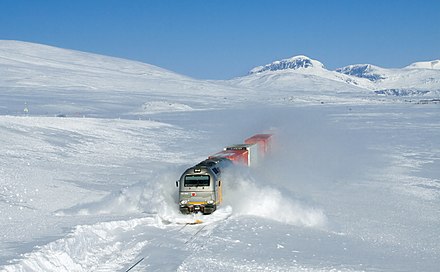 The Nordland line to Bodø runs through Helgeland.
The Nordland line to Bodø runs through Helgeland.
You will have to go through Trondheim (or Trondheim airport at Stjørdal) or Bodø to get to Helgeland by train. Trains leave and arrive several times a day, but only two a day come all the way from Trondheim (a day train and a night train). They are great if you want to have a look at the Norwegian scenery and nature, taking you from the rolling hills of Trondheim, to the weathered and rough terrain of Northern Norway. From Bodø the train runs through Saltfjellet mountain pass. Tickets from 199 kr if you book early enough.
By plane
- Brønnøysund Airport, Brønnøy (IATA: BNN), 65.461111°, 12.2175°. Small airport that takes smaller aircraft. Connections to Oslo, Bodø and Trondheim, flights often include nearby airports too. Relatively frequent flights as the airport also serves the offshore oil fields. Daily direct flights from Oslo and Trondheim with the airline Widerøe. Book well ahead for decent prices. Only 5 minutes by car from Brønnøysund.
- Mo i Rana Airport, Røssvoll (IATA: MQN Norwegian: Mo i Rana lufthavn, Røssvoll), 66.363889°, 14.301667°. Is a regional airport serving Mo i Rana in Nordland, Norway. In 2005 Mo i Rana Airport had 71,454 passengers. It is operated by Avinor. The airport is served by Widerøe with Dash 8 aircraft connecting the community to Bodø, Trondheim and other communities in Nordland and Nord-Trøndelag. The routes are operated on public service obligation with the Norwegian Ministry of Transportation and Communication. Tickets are expensive so families often drive to Bodø Airport (229 km), Trondheim Airport (447 km) or Umeå Airport (478 km) for further flights. Another option is to use the Swedish airport of Hemavan (98 km from Mo i Rana).
- Sandnessjøen Airport, Stokka (IATA: SSJ Norwegian: Sandnessjøen lufthavn, Stokka), 65.959722°, 12.472222°. Small airport that takes smaller aircraft. Connections with Oslo and Trondheim as well as airports in Nordland.
By boat
 Hurtigruten, a cruise and cargo line that operates at a number of harbors between Bergen in the south and Kirkenes in the north, including Trondheim and Bodø. Ports at Helgeland:
Hurtigruten, a cruise and cargo line that operates at a number of harbors between Bergen in the south and Kirkenes in the north, including Trondheim and Bodø. Ports at Helgeland:
By car
The E6 road is the main road, running along the entire area. From Oslo to the southern border of Helgeland it is around 800 kilometers (10 hours plus stops), and from Copenhagen around 1400 kilometers (16 hours plus stops). E6 through Helgeland is about 300 km.
Roads 73, 77 and E12 cross the border from Sweden.
Get around

By car
Traffic is generally light, but landscape is complicated and roads are of varying quality. There are no motorways. The E6 is mostly two-lane undivided. Driving is a fine way to experience Nordland's grand and ever changing landscape.
In the north-south direction there are basically only two roads:
- The E6 is the backbone road. Distances are long, 300 km between the southern county border and the arctic circle.
- The road 17 (Helgeland coast road) is a partly spectacular tourist road, connecting the coastal settlements. The coastal road runs through very fragmented landscape. It is much more time consuming than E6 and has several ferry crossings. Road 17 has been named national tourist route because of its scenery and natural beauty. A drive through Helgeland from the southern county line along the coast road to Bodø will be around than 500 km.
There are car ferries from Horn and Tjøtta (both on route 17) to Vega.
By boat
There are passenger catamaran routes from Brønnøysund and Sandnessjøen to Vega.
See
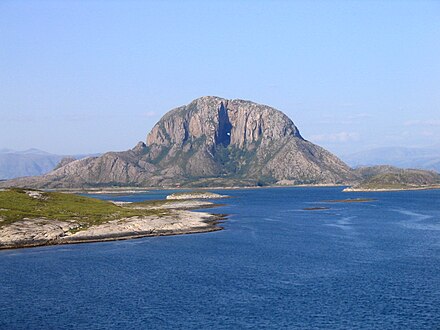
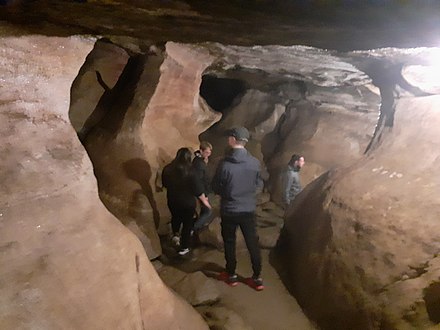
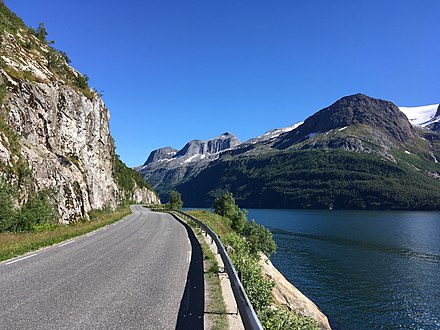
-
Engabreen branch of Svartisen glacier. Svartisen is a notable ice cap or plateau glaciers, the second largest glacier on Norway's mainland. Engabreen branch is the lowest glacier in Europe as it almost reaches the small lake few meters above sea level. The glacier can be seen from road 17.
-
Torghatten, 65.39811°, 12.09186°. some 15 kilometers outside of Brønnøysund, you have this mountain renowned for its distinctive hole piercing straight through the hillside. You really get the sense of man’s inferiority to nature when you walk through the 160 metre long, 35 metre high and 15-20 metre wide hole, created thousands of years ago by the sea’s erosion. The mountain can also be climbed, with some effort as it's pretty steep, from the southern side. From up there you have a great panorama view in all directions. free
-
Skarsåsen Fortress 5 km north-east of Brønnøysund is a German coastal fortress from the Second World War. Trenches and tunnels lead underground from the four large cannon sites. There are also many local defence sites and the remains of 11 barracks, as well as a cannon and searchlight. Today Skarsåsen is a beautiful area combining overview and insight into local and world-wide history.
-
Ørnes trading post (museum). Old trade centre.
-
Soviet graves at Tjøtta, 65.845806°, 12.393583°. More than 6,000 soviet soldiers that died in Norway during the Second World War are buried at Tjøtta.
-
Caves. Norway's bedrock is generally very old and hard, with only limited occurrence of karst landscape. The most important exception is Rana area (around Mo i Rana) in Helgeland. This area have some very long and deep caves in the marble or limestone bedrock; these are the largest and most numerous caves in Norway. The longest known cave is 25 km, the deepest about 600 meters. There are more than 100 caves in Rana. These caves are mostly for skilled cavers with appropriate equipment, but some are more easily accessible. Caves are generally protected and visitors are not allowed to take anything or leave anything behind. Pluragrotta is a long and deep cave, but is filled with water and available only for expert cave divers. Helgeland also has caves dug by ocean waves in harder rock, such as Torghatten summit.
- Grønligrotta (Grønli cave), Mo i Rana, 66.4131°, 14.2743°. main season ca 20 June–15 August. About 100 m deep and 2 km length. Artificial lighting inside. Regular guided tours in season, also for families. The most visited cave in Scandinavia. 165/110 kr 2015-12-12
- Setergrotta, Mo i Rana, 66.42066°, 14.257967°. More than 3 km long. Regular guided tours in season.
- Øyfjellgrotta, Mosjøen. About 500 m long limestone cave just outside Mosjøen town. Suitable for families.
- Torghatten, Brønnøysund, Nordland, 65.3981°, 12.0911°. Cave or hole right through Torghatten summit on an island near Brønnøysund, Helgeland coast. The hole was created by waves and ice. Free 2015-12-12
-
Dolstad church (Dolstad kirke), Mosjøen, 65.844444°, 13.203889°. A stylish octagonal-cruciform shaped wooden church built in 1734, inspired by Bakke church in Trondheim. 2020-10-18
-
Alstahaug Church (Alsthaug kirke), Alstahaug (south of Sandnessjøen on road 17), 65.893889°, 12.398611°. Built around year 1200 from soapstone and in romanesque style. Was the seat of the first bishop of Northern Norway (cathedral status) from around 1800. Petter Dass was a legendary priest at Alstahaug church in the 17th century. 2020-10-18
-
Brønnøy Church (Brønnøy kirke), Brønnøysund, 65.468889°, 12.206389°. Idiosyncratic neo-gothic parish church built in 1870. Walls from natural grey stone and window frames in striking white paint. 2020-10-18
-
Herøy Church (Herøy kirke), Silvalen, Herøy, 65.9731°, 12.278°. Biggest of the old churches at Helgeland. Built in the 12th century in romanesque style. Unlike the other churches Herøy church has an apse and covered with a hemispherical vault. 2020-10-18
-
Rock carvings in Vevelstad (Helleristning i Vevelstad), 65.7237798°, 12.4908426°. Pictures carved into rock in Vistnesdalen depict reindeer, elk, halibut, human figures, soles of the feet, boats and geometric figures. The pictures are presumably from around 4000 years BC. free 2020-10-21
-
Rødøy skier (Rødøymannen), 65.7878°, 12.5255°. Rock carvings from around 2000 years AD showing a skier, known as Rødøymannen (the man of Rødøy). This is assumed to be the oldest picture of a skier i Norway. This picture was used as a symbol for the 1952 and 1994 Winter Olympics. 2020-10-21
-
E-Huset, Vega, ienaess@online.no. Jun-Aug: Daily: 10AM-5PM. A museum telling how the eider was used, and protected, as a resource in old time.
Do
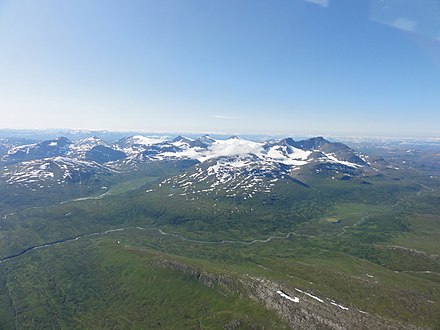
- Boat Tours. Guided boat tours in the Vega archipelago. kr 700 (includes meal)
- Helgelandstrappa (Helgeland stairway hike), 65.825139°, 13.181556°. Outdoor stairway of natural, local stones through the hill above Mosjøen and Vefsn river. About 3000 steps. Will reach the summit at 800 meters above the fjord when complete (expected in 2020 or 2021). Free
- Saltfjellet mountain pass, 66.552583°, 15.323631°.
Crossing the Arctic Circle on the mountain Plateau. The approximate midpoint of E6 in Norway, 1300 km from Kirkenes and 1300 km from Gothenburg.
- Børgefjell nasjonalpark (Børgefjell national park), 65.1833°, 13.9°. A high mountain national park in southern Helgeland, along the border with Sweden and partly in Trøndelag. The park is relatively undeveloped with few trails or other facilities for visitors. The E1 Long Distance Path passes through the park but is not marked in the terrain here. The area was protected as national park in 1963, the second such in Norway. The protected area covers som 1,500 km². Free
- Kayak among the myriad of islands. Possibly the best kayak area in Norway.
- Island hopping by bicycle. Cycling is a fine way to experience the grand nature of Helgeland coast. Some islands are connected by bridge and some only by infrequent car ferry or passenger boat. Visitors should read maps and get timetables. Roads run mostly along shores and there are few hills.
- Zipline Mosjøen, 65.825139°, 13.181556°. Zipline from Øyfjellet mt across mouth of Vefsna river to downtown Mosjøen. 790 NOK 2020-11-06
Sleep

;Brønnøysund
- Thon Hotel Brønnøysund. Valveien 11. Thon Hotel Brønnøysund is located in the center Brønnøysund on the Helgeland coast.
;Vega
- Gårdsøya Rorbuer, Vega, +47 95768028, post@gardsoyarorbuer.no. Fishermans style six bed apartment by the ocean. kr 1000
- Vega Brygge, Igerøy, Vega, +47 75035433, didrik@tersen.com.
- Vega Havhotell, Gladstad, Vega, +47 75036400, vega@havhotellene.no.
Eat
- Vega Vertshus, Viksås, +47 75035400, post@vegavertshus.no.
Talk
Norwegian is the official language of Norway and Helgeland has a dialect of Norwegian. Norwegian is mutually intelligible with Danish and Swedish. The Helgeland dialect belongs to the Northern Norway family of dialects, but has a notable difference in melody of words and sentences. Norwegian and Swedish are among the few European languages with pitch-accent.
Most Norwegians speak English well. In theory, all Norwegians are also able to speak a third language, usually German or French (but also Spanish, Italian or Russian), as learning a third language is mandatory in the Norwegian school. However, most people's knowledge of their third "school language" is basic at best.
Stay safe
.jpeg/440px-D%C3%B8nna_Norway_(220175675).jpeg) Helgeland is generally a very safe place to visit. If you go out on the sea for fishing or diving, check the local weather forecasts as rapid weather changes can occur, as if you go trekking. The North Atlantic weather can be rough and waves can be treacherous particularly beyond the protective islands and skerries. If you go in the winter or up in the mountains, you should have some knowledge about when you need special skills.
Helgeland is generally a very safe place to visit. If you go out on the sea for fishing or diving, check the local weather forecasts as rapid weather changes can occur, as if you go trekking. The North Atlantic weather can be rough and waves can be treacherous particularly beyond the protective islands and skerries. If you go in the winter or up in the mountains, you should have some knowledge about when you need special skills.
Go next
- Bodø and Salten area, north of the Arctic circle
- Trøndelag
- Västerbotten County in Sweden
